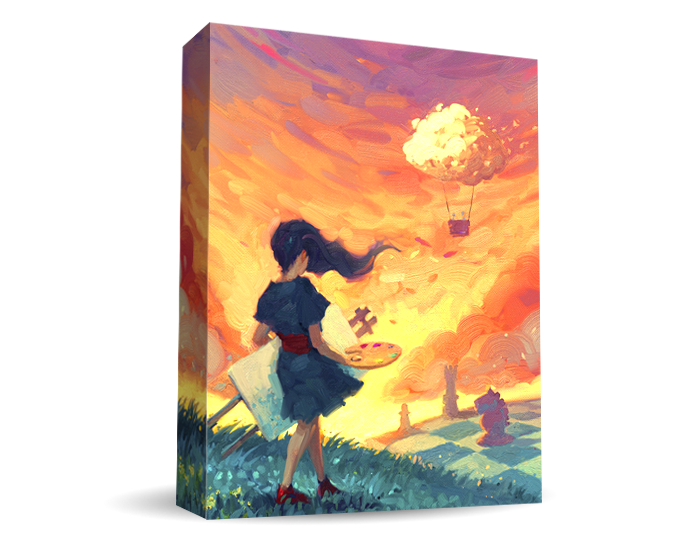Canvas
review by Kendra
I would like to share with you the game “Canvas” by Jeffrey Chin, Andrew Nerger, and illustrated by the independent artist Luan Huynh. This Art Game blew me away and helped restore my love of the Art Game genre. I’m not alone in lauding this game, as it has received oodles of awards, including multiple awards recognizing the quality of this game’s art. It has won the Dice Tower Seal of Excellence and 3 more prestigious awards from Dice Tower: Best Game Artwork Winner, Best Welcoming Game, and Best Small Publisher. This game has been recognized by the Golden Geek Awards, 3 Minute Board Games, Tabletop Gaming, Geek Media, Golden Meeple, and The Dragon’s Tomb.
Canvas is a competitive game in which 1-5 players attempt to make the most beautiful painting. The method by which the paintings are judged is surprisingly crunchy, allowing for the heavyweight, euro-style gamers to engage with the puzzle presented by the game and to also speculate on how best to block their opponents. However, this is one of those games that also allows for non-competitive individuals, like myself, to fully engage with the game without diminishing the fun of more aggressive players.
In Canvas, players draft cards to create paintings, layering 3 transparent cards atop one another from a communal draft lineup. Players are limited in the range of cards available based on how many inspiration tokens they are able to leave as incentive over every card in the lineup that is skipped. Judging is based on element symbols listed at the bottom of each card. This requires players to maintain a fluid mindstate as they play, as the most optimal card for their array might be snatched up, or they might not have the requisite inspiration tokens to reach sufficiently far down the lineup. This is the beating heart of the competitive side of Canvas: the constant evaluative flux with the limited, mercurial currency bartered between juggernauts of artistic creation.
What this also means is that the less competitive players. who are first and foremost working on making a lovely painting, tend to have access to the largest number of inspiration tokens. And here is where the game surpassed my expectations and earned the title of permanent resident within my collection: this game is beautiful just to play even without the beautiful, inbuilt drive to win. While my heavyweight gaming friends battled and maneuvered to hold the absolute most points, I was able to play for the sake of play, and this game catered to my gentler play style.
This game is fabulously beautiful, but to encapsulate the whole of the beauty, I’ll sift this game into its various constituent lovely parts.
The cards are wonderful and thoughtfully designed with 310 gsm premium ivorycore cardstock. Each transparent card comes with either the first or second half of a title, such as a card with “Terrible” as the first half combining with a card with “Nature” as the second half, making the title: “Terrible Nature”. The transparent film and artistic designs are stunning. Players who seek a particular color when playing can select “red” or “green” as the background for their paintings; the reverse side of each backdrop card is designed to look like the back of a canvas painting with the wood frame and stretched canvas. The random array of scoring arrangements is large enough that I have yet to play a game where the point maximizers could envision the most ideal lineup at the very onset and, even here, there is attention to artistic detail. The scoring cards, when flipped over, have detailed rules for how the scoring works including examples, meaning that it is never necessary to consult the rulebook during play. The cards fit perfectly on the cloth, roll-out mat and the art is center stage, while the cloth mat’s layout is easy to read and inviting. The components are well-made and densely pigmented being clear in their purpose just at a glance, reinforced by the rules manual.
And here we come to the design of the packaging and how it all comes together. The interior of the box is a pale lavender with white outlines suggesting where each component should go. Baggies are included for tokens and a card case is offered for all the cardstock cards. Card protectors are included in the box, and they feel to be about 70 microns thick, which is substantive but not over-the-top. The tokens have suggested placements in white outlines in the box, as do the cards and card case. The lid closes easily however, even when the game is hurriedly shoved back in the box after play. To top this all off, the board game has been designed to be “hangable.” What this means is that the box itself is a piece of art and does not need to take up space on a game shelf; the box itself may be hung as a painting.
My favorite games are those that cater to gaming circles with diverse play styles and this game absolutely hits the mark.
Canvas is available now from our webstore.
